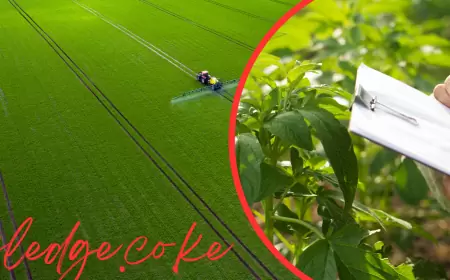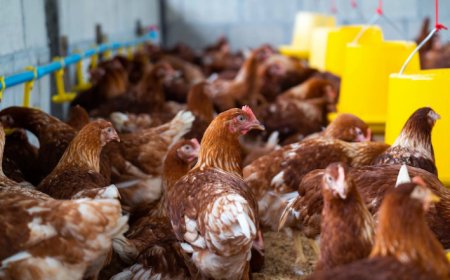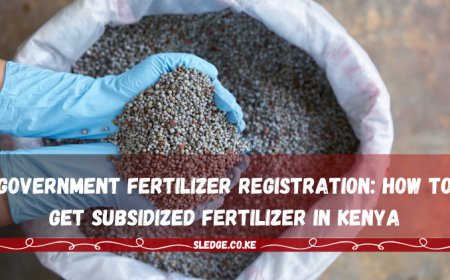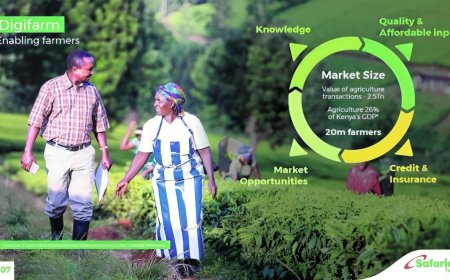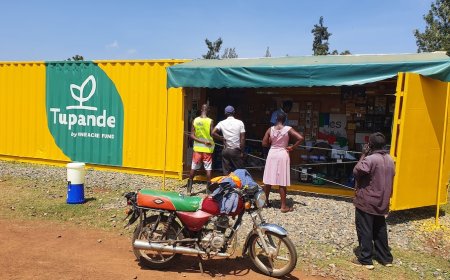Passion Fruit Farming in Kenya 2024: Types, Ideal Conditions, Challenges, and Revenue Analysis
Explore everything about Passion Fruit Farming in Kenya, from types planting methods to market strategies and profit calculations, in this detailed guide.

Passion fruit farming in Kenya, a vibrant and vital component of the country's agricultural sector, has been blossoming in recent years. As we navigate through 2024, this enterprise continues to hold a significant position in Kenya's agronomy, not just for its economic benefits but also as a symbol of agricultural diversity and resilience. The growth of passion fruit farming reflects a story of both challenges and triumphs, weaving a narrative that resonates with the spirit of Kenyan farmers. It's a story that blends traditional agricultural practices with modern innovation, highlighting a journey of adaptation and growth.
But what makes passion fruit farming such a compelling chapter in Kenya's agricultural saga? This blog post aims to peel back the layers of this intriguing industry. We'll dive into the essential elements that define passion fruit farming in Kenya, exploring the varieties that thrive in its soils, the ideal conditions they require, and the cultivation techniques that have been honed over time. Furthermore, we'll address the challenges faced by farmers, including pest and disease management, market access, and the critical aspect of profitability. In doing so, we'll not only illuminate the current state of passion fruit farming in Kenya but also offer insights and guidance for those looking to contribute to this vibrant sector.
READ ALSO: Amiran Kenya: Who Are They, Contacts, and Physical Offices in 2024
The Basics of Passion Fruit Farming
Types of Passion Fruit Grown in Kenya
In the lush landscapes of Kenya, various passion fruit varieties flourish, each with its unique characteristics and adaptability to the Kenyan climate. The Purple Passion Fruit (Passiflora edulis var. edulis) stands out for its adaptability to diverse climatic conditions, making it a favorite among Kenyan farmers. This variety is known for its deep purple hue and sweet, tangy flavor, making it a popular choice in local and international markets.

On the other hand, the Yellow Passion Fruit (Passiflora edulis var. flavicarpa), thrives in warmer regions, offering a slightly larger fruit with a more acidic taste, ideal for juice production. Additionally, varieties like Sweet Granadilla (Passiflora ligularis) and Giant Granadilla (Passiflora quadrangularis) are gaining traction, each bringing a unique flavor profile and nutritional value to the Kenyan passion fruit palette.
Ideal Growing Conditions
The success of passion fruit farming hinges on providing the ideal growing conditions, which include soil, climate, sunlight, and wind protection.
- Soil: Passion fruit vines require well-drained soils, rich in organic matter. The ideal pH range is slightly acidic to neutral, between 6.0 and 7.0. Ensuring good drainage is crucial to prevent root diseases and waterlogging.
- Climate: These vines thrive in a subtropical to tropical climate, favoring warm conditions with temperatures ranging from 20°C to 30°C. They demand a frost-free environment to flourish.
- Sunlight: A key ingredient for healthy growth and fruit production is ample sunlight. Passion fruit plants need about 6-8 hours of direct sunlight daily to ensure optimal growth and fruit development.
- Rainfall: Regular rainfall benefits the vines, although they can withstand short drought periods. In areas with less rainfall, supplementary irrigation is necessary to maintain consistent growth.
- Wind Protection: In windy regions, providing windbreaks is vital to protect the delicate vines and ensure stable growth.
Planting and Cultivation Techniques
The journey of a passion fruit from seedling to fruit-bearing vine involves meticulous planting and cultivation techniques.
- Site Preparation: Choose a site with good drainage and fertile soil. Clear the land of debris and weeds, and enhance soil fertility with organic matter like compost.
- Planting: Dig pits or trenches approximately 2 feet wide and 2 feet deep, with spacing dependent on the variety and local recommendations. Use healthy seedlings, ensuring the roots are adequately covered with soil.
- Watering: Immediately after planting, water the seedlings to establish the root systems. Regular watering, especially in the dry season, is crucial for the vines' growth.
- Support Structures: As climbing vines, passion fruits need support structures like trellises for vertical growth. This not only aids in better fruit development but also facilitates easier harvesting.
- Mulching: Apply organic mulch around the base of the plants to retain soil moisture, regulate temperature, and suppress weed growth.
Challenges and Solutions in Passion Fruit Farming
Common Pests and Diseases
Passion fruit farming, while rewarding, is not without its challenges, particularly when it comes to pests and diseases. Here's a look at some common threats and how to effectively manage them:
- Aphids, Mealybugs, and Scales: These tiny pests feed on sap, weakening the plants. They can be controlled using targeted insecticides like KINGCODE ELITE 50EC or natural predators like ladybugs for organic farming.
- Cutworms and Fruit Flies: Cutworms attack the stem at the soil level, while fruit flies target young fruits. Effective control involves soil drenching with products like PROFILE 440EC and spraying insecticides like PENTAGON 50EC.
- Mites: Mites cause yellowish patches on leaves, leading to defoliation. They can be managed by spraying acaricides such as ALONZE 50EC.
- Fusarium Wilt and Brown Spot: These are fungal diseases causing wilting and leaf spots, respectively. Prevention includes using resistant varieties and fungicide applications like RANSOM 600WP.
- Dieback: This disease leads to wilting and death of shoots. Pruning affected parts and applying copper-based fungicides are effective management strategies.
Market Access and Profitability
Marketing and profitability are critical aspects of passion fruit farming. Here's how to address these challenges:
- Accessing Markets: Establishing connections with local and international buyers can open up new avenues for sales. Online marketplaces and agricultural trade fairs are great platforms for networking.
- Improving Profitability: Value addition, such as making passion fruit juice or jam, can significantly increase profitability. Also, adopting sustainable farming practices can reduce costs and appeal to environmentally conscious consumers.
- Packaging and Processing: Investing in proper packaging and processing techniques can enhance the shelf life and market value of the fruits. This can be particularly beneficial for export markets.
- Utilizing Technology: Leveraging agricultural technology for better crop management and market analysis can lead to more informed decisions, ultimately enhancing profitability.
Financial Aspects and Profitability of Passion Fruit Farming
Initial Investment and Running Costs
Understanding the financial commitment required to start and maintain a passion fruit farm is crucial. Here's a breakdown of the key expenses:
- Land Preparation and Planting: This includes land clearing, ploughing, and setting up trellises for the vines. The costs vary but generally range between Ksh 20,000 to Ksh 50,000 per acre.
- Seedlings and Planting Material: Quality seedlings are essential for a healthy crop. Depending on the variety, the cost of seedlings can range from Ksh 10 to Ksh 20 per plant.
- Irrigation Systems: Given the climate of Kenya, implementing a drip irrigation system is often necessary, which may cost between Ksh 30,000 and Ksh 50,000 per acre, including installation.
- Fertilizers and Soil Amendments: Regular application of fertilizers is key for optimal growth. Annual expenses here can be between Ksh 10,000 to Ksh 20,000 per acre.
- Pest and Disease Control: Budgeting for pest and disease management is vital. This can include costs for pesticides and biological control measures, typically ranging from Ksh 15,000 to Ksh 30,000 per acre.
Revenue and Profit Calculations
To gauge the profitability of passion fruit farming, let’s consider a simplified profit calculation:
- Revenue Estimation: Assume an annual yield of 25,000kgs per acre, with a selling price of Ksh 80 per kilogram. The total annual revenue would be Ksh 2,000,000 (25,000 kg x 80 Ksh/kg).
- Subtracting Costs: If the production costs amount to Ksh 500,000 per acre, the net profit would be Ksh 1,500,000 (Ksh 2,000,000 – Ksh 500,000).
It’s important to note that these figures are estimates and actual profits can vary. Factors like market demand, climatic conditions, and effective farm management play significant roles in determining the actual profitability.
By carefully managing the initial investment and running costs, passion fruit farming can be a lucrative venture. The key lies in efficient farm management, cost control, and tapping into the right markets.
READ ALSO: Tomato Farming in Kenya 2024: Best Varieties, Disease Control, and Market Trends
Frequently Asked Questions About Passion Fruit Farming in Kenya
What are the best passion fruit varieties for farming in Kenya?
- In Kenya, the Purple Passion Fruit (Passiflora edulis var. edulis) is widely favored for its adaptability and sweet taste. The Yellow Passion Fruit (Passiflora edulis var. flavicarpa) is preferred in warmer areas for its acidic flavor, ideal for juices. Sweet Granadilla (Passiflora ligularis) offers a unique taste and is also gaining popularity.
What is the recommended spacing for planting passion fruit in Kenya?
- The recommended spacing for planting passion fruits varies with the variety. Generally, a spacing of 2 meters between plants and 3 meters between rows works well, providing adequate space for growth and air circulation.
How long does it take for passion fruit to mature and produce fruit in Kenya?
- Typically, passion fruit vines start producing fruit about 12 to 18 months after planting. This timeframe can vary slightly depending on the specific variety and growing conditions.
What are the key factors for a successful passion fruit harvest?
- Successful passion fruit farming hinges on several factors: selecting the right variety, ensuring ideal growing conditions (soil quality, sunlight, and water), effective pest and disease management, and proper vine training and pruning.
Conclusion
Passion fruit farming in Kenya is more than just a cultivation practice; it's an endeavor that combines tradition, innovation, and a deep-rooted passion for agriculture. As we look towards the future, this sector holds immense potential for economic growth, both for individual farmers and the nation as a whole. With the right approach, including informed decision-making, adoption of modern farming techniques, and a commitment to quality, Kenyan farmers can not only sustain but also amplify their presence in the global fruit market. The path of passion fruit farming is paved with challenges, yet it promises a bountiful harvest for those willing to embark on this journey with dedication and foresight. Here's to the continued growth and prosperity of passion fruit farming in Kenya!









































